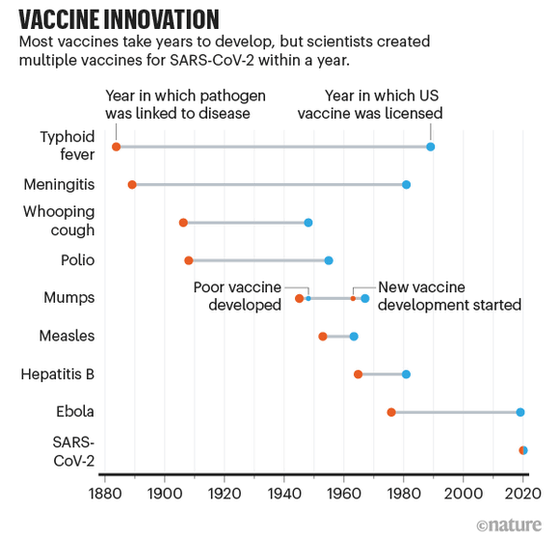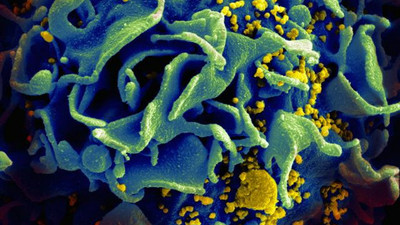Why was the new corona vaccine developed so fast?

The fastest vaccine ever developed was the mumps vaccine developed in the 1960s, which took four years to develop. Therefore, it was thought that it would take some time to complete the vaccine for the new corona virus (SARS-CoV-2), but in November 2020, American pharmaceutical giant Pfizer and biotechnology company BioNTech The new coronavirus vaccine ' BNT162b2 ' developed by SE was found to have 'more than 90% preventive effect' in a phase III study, and was first used by the US Food and Drug Administration (FDA) on December 14, the same year. We have obtained permission . The journal Nature summarizes why the development of the new coronavirus vaccine, which was completed in less than a year, which is much shorter than the conventional vaccine development, is progressing so fast.
The lightning-fast quest for COVID vaccines — and what it means for other diseases
https://www.nature.com/articles/d41586-020-03626-1

Dan Baruch, director of the Center for Virology and Vaccine Research (CVVR) at Harvard Medical School, said his experience in developing vaccines for the new coronavirus infection (COVID-19) 'will make a big difference in the future.' He says. 'The history of the development of the COVID-19 vaccine shows how fast vaccine development can be done in the face of a global emergency if sufficient resources are available for research,' said Baruch. .. In addition, Mr. Bharuch said that new methods in vaccine development such as 'methods using mRNA ' have been verified in the development of COVID-19 vaccine, '(these new methods) impair safety. It has been shown that the development process can be significantly accelerated. '
Below is a graph comparing the time it took to develop the COVID-19 vaccine with another vaccine for infectious diseases. The COVID-19 vaccine has been developed in less than a year, but we can see that other infectious disease vaccines have been developed over a fairly long period of time.

Nature argues that the rapid development of the COVID-19 vaccine is not only due to the adoption of new development methods, but also 'a huge amount of money that allows companies to conduct multiple trials in parallel. The world has succeeded in developing the COVID-19 vaccine faster, as regulators have taken action on approval faster than usual. ' He pointed out that if these efforts are incorporated into vaccine development other than the COVID-19 vaccine, it may be possible to develop any vaccine more quickly in the future.
But at the same time, Nature notes that 'there is no guarantee.' A huge amount of money is required for high-speed vaccine development like the COVID-19 vaccine, but in order to secure a huge amount of money like the development budget for the COVID-19 vaccine, 'Society like the new coronavirus' There needs to be physical and political urgency, 'Nature argues. In addition, it is a virus that mutates relatively slowly like SARS-CoV-2 and is being studied by many scientists, so 'high-speed vaccine development has become possible.'

In the first place, there was no research on the development of COVID-19 vaccine as of January 2020. However, due to the presence of other coronavirus infections such as
In addition, Akiko Iwasaki, an immunologist at Yale University School of Medicine, who has been working on the development of nucleic acid vaccines based on the length of DNA and RNA, said that mRNA vaccines such as 'BNT162b2' have been available for the past 10 to 15 years. He points out that he is benefiting from years of basic research on DNA and RNA vaccines. Mr. Iwasaki pointed out that a pandemic of the new coronavirus occurred at the timing when the technology related to DNA / RNA vaccine matured. 'If it was five years ago, the technology related to RNA vaccine was not mature and COVID-19 I wouldn't have been ready to develop a vaccine, 'he said.

In addition, researchers at the National Institute of Allergy and Infectious Diseases (NIAID) have learned from research on MERS and SARS that the best way to stabilize the SARS-CoV-2 spike protein before it binds to host cells. I understood that was 'adjusting the RNA sequence'. 'It could be a much better vaccine antigen,' said Bernie Graham, a vaccine researcher at NIAID, if the spike protein could be stabilized before it binds to the host cell. In fact, NIAID is developing a vaccine in cooperation with Moderna , which develops the COVID-19 vaccine, and it seems that NIAID's knowledge has succeeded in making a smooth start to vaccine development by the two parties. 'People were paying close attention to coronaviruses (other than SARS-CoV-2), which really accelerated the entire COVID-19 vaccine development process,' said Dean. 19 He says it helped a lot in the development of the vaccine.
Unlike viruses such as human immunodeficiency virus (HIV), herpes virus, and influenza virus, SARS-CoV-2 is relatively slow to mutate and does not have the effect of nullifying the human immune system. In contrast, the herpes virus is highly evasive and actively blocks antibody binding, making it very difficult to find an effective drug for herpes. Influenza viruses also mutate rapidly, requiring different vaccine preparations each season. It is clear that the fact that SARS-CoV-2 did not have these characteristics also contributed to the acceleration of vaccine development.

In addition, 'funds' are a major bottleneck in vaccine development, but in the case of the development of the COVID-19 vaccine, the development proceeded very smoothly due to the large amount of funding provided. Rino Rappuoli, chief scientist in the vaccine division of pharmaceutical company
'Ebola, which destroyed the African community, did not provide such large-scale funding for vaccine development, so it took a considerable amount of time to develop a vaccine for Ebola, while COVID- The 19 has caused financial crises in every country in the world and has received a lot of financial support, which means that vaccine development for existing infectious diseases such as Ebola is not so rapid. It suggests that there will be no such thing, 'he said, pointing out that COVID-19, which involved the economic powers and caused the pandemic, provided a large amount of financial support for the development of the vaccine.
'Not only did we want to stop the pandemic, but the abundant funding from government agencies could have motivated pharmaceutical companies to develop vaccines,' said Peter Hotez, a virologist at Baylor College of Medicine. I told you. In addition, it is important that the spread of infectious diseases such as Ebola hemorrhagic fever, deca fever, and SARS before the COVID-19 epidemic created an infrastructure to respond to the infectious disease crisis, Hotez said. 'If SARS was as prevalent as COVID-19 in 2002, the vaccine development technology was not as advanced as it is now, and there was no infrastructure to deal with infectious diseases, so COVID. It could have been a lot more difficult than the -19 pandemic. '
In particular, the Coalition for Epidemic Infectious Diseases Innovation (CEPI) played a major role as an infrastructure for infectious disease control. CEPI was founded in 2017 with the goal of building the technical infrastructure needed to quickly and affordably develop vaccines against potentially epidemic infectious diseases such as MERS, Ebola and Zika fever. To do. ' CEPI has funded research at Moderna and Oxford University, which can be said to have contributed significantly to the development of the COVID-19 vaccine.

There are multiple viruses that can infect humans, but unlike SARS-CoV-2, multiple factors do not always combine to enable rapid development. Therefore, Graham argues that 'we need to know more about viruses' in preparation for a future crisis, and by building a solid platform for basic science, we can develop future infectious disease control and vaccines. Nature notes that it can be of great help.
Related Posts:
in Science, Posted by logu_ii







